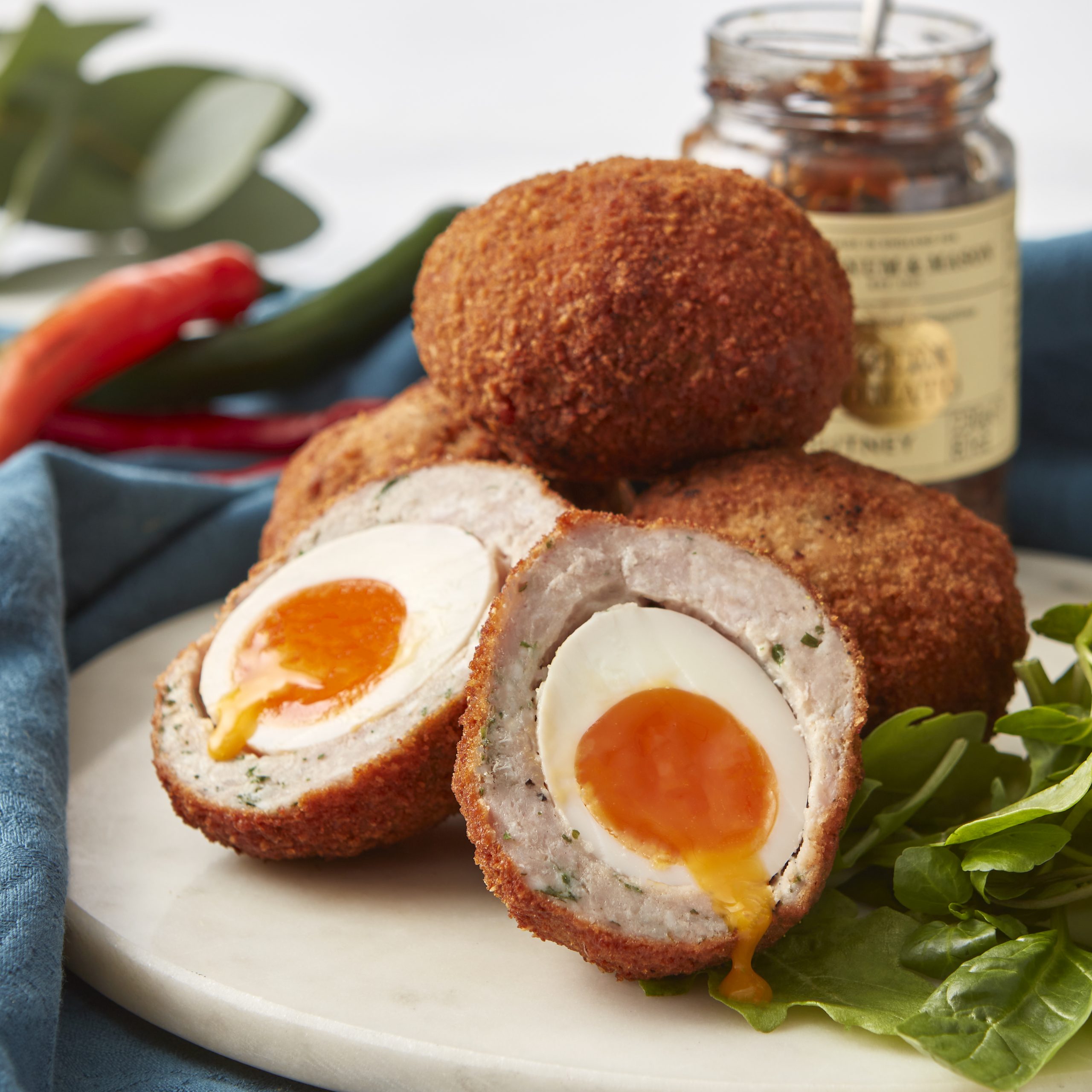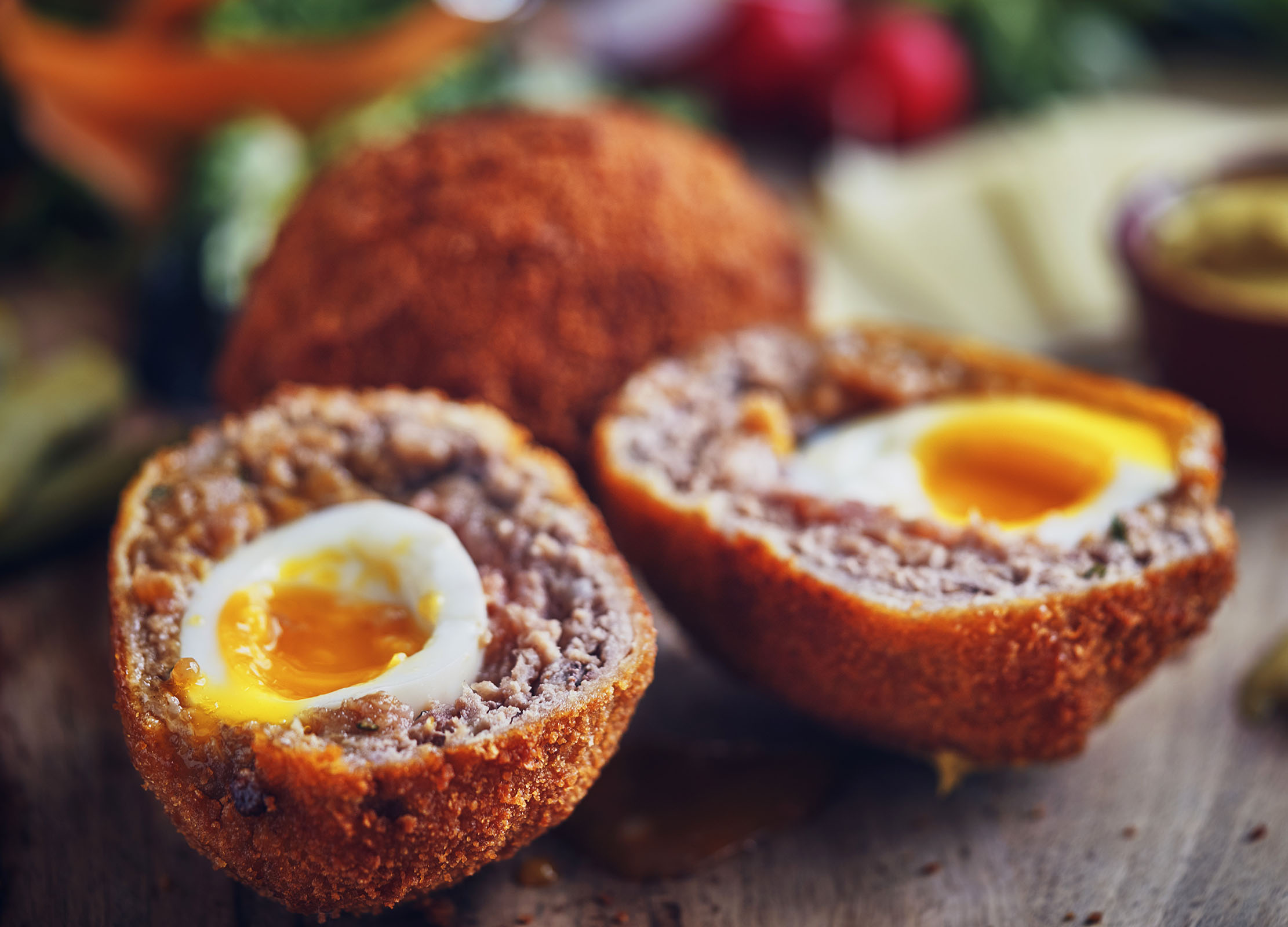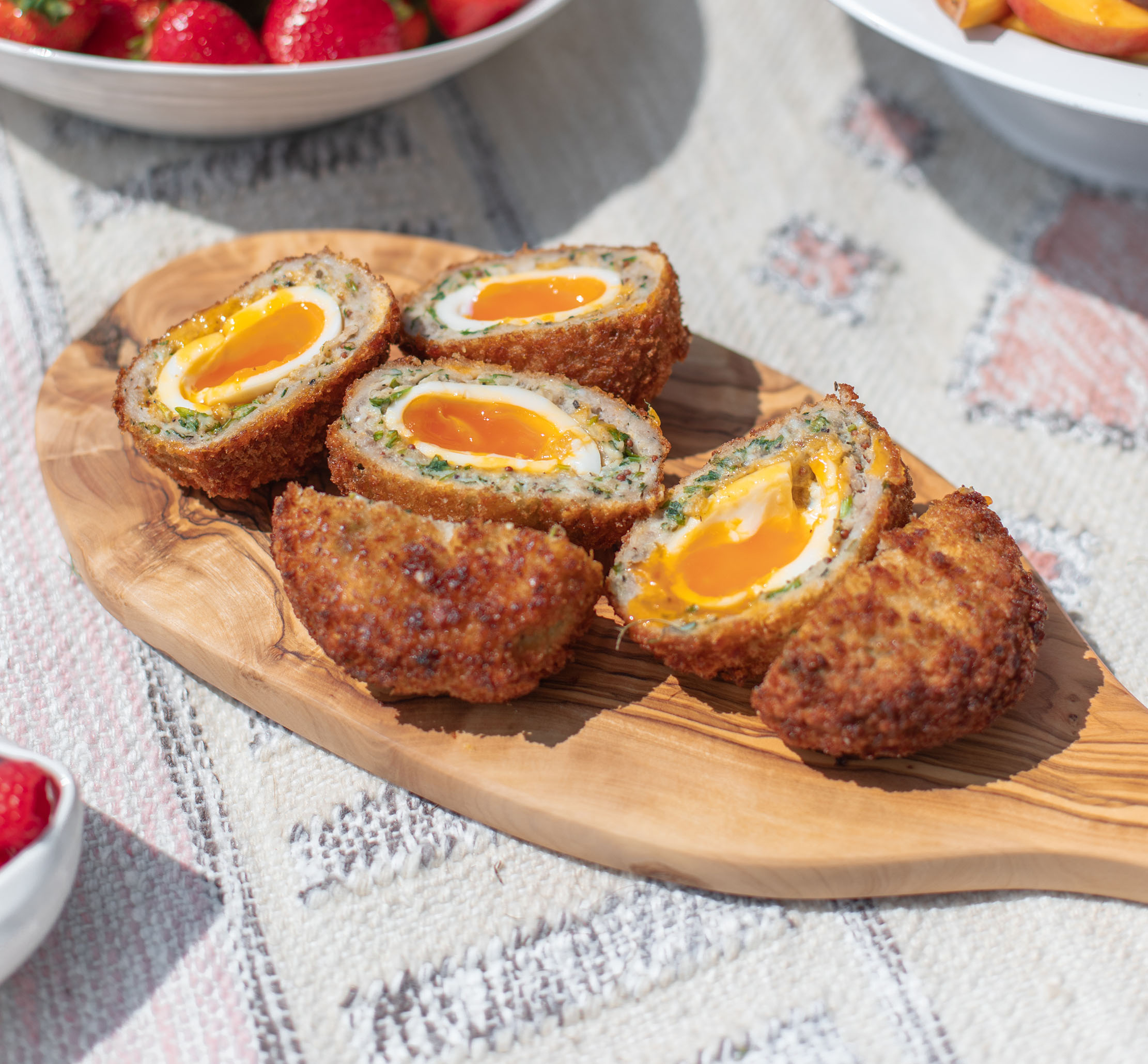Scotch eggs: Tom Parker Bowles on the delights of this 'absolutely magical thing'
The jury is out as to whether the humble Scotch egg is a snack or a ‘substantial meal’. Either way, this headline-stealing, hand-held hero is outrageously delicious, says Tom Parker Bowles.


There’s much to be said for the Scotch egg.
A proper one, of course, not those neon-hued abominations that lurk in the depths of service-station chiller cabinets, all wan, gristly meat, squash-ball-textured white and yolk the colour of despair. These grim ovoid mountebanks are fit for nothing, save weapons of mass indigestion. ‘Can you smell my breath?’ asks north Norfolk legend Alan Partridge, in I’m Alan Partridge, of his long-suffering PA, Lynn. ‘It smells a bit like gas,’ she replies with a grimace. ‘It’s those Scotch eggs we had at the petrol station last night.’ I rest my case.
As it is with so many great British snacks (pasty, pork pie, sausage roll), the devil is in the detail. A good free-range egg, boiled for no more than six minutes, so the yolk, the colour of a chocolate-box sunset, sits on the jammy side of oozing. And that egg, held in the loving caress of good, free-range pork, judiciously seasoned and tasting of a life well lived — before being coated in breadcrumbs, gently lowered into clean oil, smoking hot, and deep fried for a few minutes until burnished and crisp. As Oisín Rogers, pub master and creator of the Scotch Egg Challenge (about which more later), so rightly points out: ‘It’s an absolutely magical thing. And, of course, you can eat it standing up with a pint in your other hand. What’s not to love?’ What’s not to love, indeed.
The Scotch egg even hit the headlines during the dark depths of lockdown, when the ever-hapless Matt Hancock, with his inane covid eating and drinking regulations, agreed with then environment secretary George Eustice that the snack counted as a ‘substantial meal’, therefore making it the pint lover’s best friend. Probably the most sensible thing Mr Hancock ever said.
Anyway, despite its name, there’s precious little Scottish about this particular hand-held hero. Some argue that the name comes from the alternative meaning of ‘Scotch’, meaning to cut, score or gash. Or that it’s a sly dig at the ‘auld enemy’ and their supposedly parsimonious ways — as in Scotch woodcock, a dish that substitutes the delicate gamebird with a rather more affordable anchovy fillet. Yet neither stand up to serious examination and the connections are tenuous, at best.
A far more appetising theory is the Scotch egg’s inclusion in Meg Dods’s The Cook and Housewife’s Manual, published in Edinburgh in 1826, the first time its name appeared in print. In it, the eggs are served hot, with gravy, as they are in Mrs Beeton’s eponymous (and hugely overrated) Book of Household Management, of 1861. But it was actually back in 1809, in M. E. Rundell’s A New System of Domestic Cookery (an unappreciated classic), that the recipe first appeared, albeit untitled. ‘Boil hard five pullet’s eggs, and without removing the white, cover completely with a fine relishing forcemeat.’
That’s not to say that eggs weren’t being enveloped in mincemeat for many centuries previously, in times when recipe books were the preserve of the rich. (Just as it seems ridiculous to pretend the Earl of Sandwich was the first man to jam a slice of beef between two hunks of bread — merely a pretty tale.)
Sign up for the Country Life Newsletter
Exquisite houses, the beauty of Nature, and how to get the most from your life, straight to your inbox.
Fortnum & Mason, that venerable Piccadilly institution, does claim to be the creator of this portable egg-centred classic, back in 1738. The theatrical historian W. Macqueen-Pope describes, in Goodbye Piccadilly, reading documents in the shop’s archive that provided concrete proof.
Sadly, there’s no sign of the papers today, as much of the archive was destroyed by Luftwaffe bombs. Still, Fortnum’s has been closely linked with the Scotch egg ever since and makes a particularly fine version (which you can make yourself using the recipe at the bottom of this page).

As to variations on a Scotch-egg theme, there are literally hundreds — from the sublime (it’s pretty hard to beat Heston Blumenthal’s classic at The Hind’s Head in Bray, Berkshire) to the dull (I’m looking at you, Turkey Christmas Lunch) to the frankly deranged (anything in a 24-hour petrol station). Fortnum’s very own Chotch egg added dark chocolate to a venison mix.
There was even a pork-and-offal larb (a northern Thai, spicy meat salad) version, created by London’s Smoking Goat restaurant, winner of the 2019 Scotch Egg Challenge, an event that has been running for more than 10 years. ‘It’s always a huge success,’ Mr Rogers tells me, between sips of perfectly poured Guinness, ‘because we managed to get some of the most creative operators and chefs together to have a massive egg-off. It was brilliant for the craic and the camaraderie and the swapping of tales over booze.’
There was no event this year, as he’s busy opening his new (and hotly anticipated) pub, The Devonshire, behind Piccadilly Circus, London W1. But worry not, eggheads, as it will be back. ‘I can’t wait to resurrect the thing again next year. Purely as an excuse to get a big load of lunatics together talking about something outrageously delicious over a few creamy pints.’
As to my own favourites, I’m rather a purist, although a little extra chilli, black pudding or chorizo, mixed in with the pork, will never go amiss. The Harwood Arms, London SW6, does a splendid venison version and you’ll never go wrong with the beauties from Fortnum’s, The Ginger Pig or H. G. Walter. I’m also a fan of The Handmade Scotch Egg Company, which has a huge variety, from the Blackfire (Scotch bonnet chilli and black pudding), to the Amore (paprika and fennel seeds) and the Old Stager (pickled egg, rolled in broken crisps). Serve with a great blob of English mustard or a punchy pile of crisp piccalilli. Eggy enlightenment awaits.
Recipe: Fortnum & Mason's Scotch Egg
Ingredients
Makes 8
- 650g sausage meat
- ½tspn ground allspice
- ½tspn dried white pepper
- ½tspn fine salt
- 2tspn dried oregano
- 1tspn dried sage
- 1 garlic clove, crushed to
- a paste with a pinch of salt
- 1 small shallot, finely chopped
- 10 medium eggs
- 100g plain flour
- 100g breadcrumbs, preferably
- Japanese panko crumbs
- Vegetable oil, for deep frying
Method
Mix the sausage meat with the spices, salt, dried herbs, garlic and shallot.
Add eight of the eggs to a large pan of gently simmering water and cook for six minutes. Drain and put in a bowl of cold water. Peel off the shells.
Divide the meat into eight portions. Roll each one out between clingfilm. Lightly flour the eggs, then wrap each one in meat, roll in clingfilm and twist the end tightly to help shape the eggs.
Put the remaining eggs into a shallow bowl and beat. Put the rest of the flour in another bowl and the breadcrumbs in a third. Remove the clingfilm, then dip the Scotch eggs first in flour, then in beaten egg and finally in breadcrumbs.
Heat the oil in a deep-fat fryer or deep saucepan, to 170˚C, adding the Scotch eggs in batches, so as not to overcrowd the pan. Fry for 7–8 minutes, until a rich golden brown, then drain well on kitchen paper. Serve warm with piccalilli.

10 of the best British pies, from the Scotch to the Stargazy
Pies are a great British culinary tradition – but what they consist of varies enormously depending on where you are. Flora

How to make perfect scotch eggs, for the ideal back garden picnic
This recipe from top caterers Doggart & Squash will help you make that type of delicious, fresh scotch egg which
Tom Parker Bowles is food writer, critic and regular contributor to Country Life.
-
 What should 1.5 million new homes look like?
What should 1.5 million new homes look like?The King's recent visit to Nansledan with the Prime Minister gives us a clue as to Labour's plans, but what are the benefits of traditional architecture? And can they solve a housing crisis?
By Lucy Denton
-
 Having a ruff day: Kennel Club exhibition highlights the plight of vulnerable spaniel breeds
Having a ruff day: Kennel Club exhibition highlights the plight of vulnerable spaniel breedsPhotographer Melody Fisher has been travelling the UK taking photographs of ‘vulnerable’ spaniel breeds.
By Annunciata Elwes